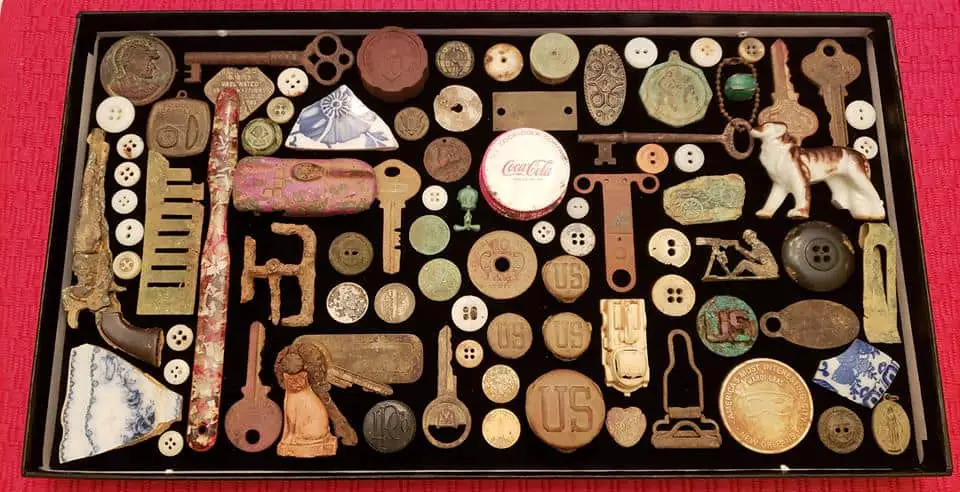
There are tons of metals that you could potentially find using Metal Detectors!
Brass, Bronze, Platinum, Titanium, Tungsten, Gold or even junk metals are all detectable metals.
But, what if you are looking for Gold or you are only targeting Platinum. Or let’s say it this way … You are targeting a specific Metal or range of metals instead of others!
Would your machine be able somewhat to differentiate between them? In this Post I will share with you exactly what I know about that, so hopefully you will learn useful and practical information …
Can Metal Detectors Tell the Difference between Metals?
Differentiating between metals has been one of the primary concerns since metal detecting became a thing. A large amount of metal is buried underground, but not all of it is valuable or desirable.
Metals like gold, silver and platinum are considered desirable while others are considered pretty mush as “trash”.
There are various techniques to differentiate between metals today. Usually, cheaper machines don’t have enough technological capabilities differentiating between metals.
Older techniques like Pulse Induction also don’t have the capacity to get that done, while newer ones like VLF do. Tones are also a great way to identify the metal in question.
This is also accompanied with numbered IDs that could tell you exactly what the detected metal is. Not only can metal detectors differentiate between metals, they can also mute certain metals and only observe others.
Differentiate with Discrimination
Perhaps the most common technique to differentiate metals is discrimination. Every metal produces a different phase response when subjected to AC.
By recording the phase response, detectors can understand which metal is in question. Furthermore, the machines could be programmed so that they only respond to certain metals and ignore all others. This technique is known as discrimination.
Discrimination is so popular because it is easy to implement; you only need to set the detectors to ignore or observe certain phase response. However, the technique is not effective in case of metals with similar phase response, like tinfoil and gold.
A good example of a machine that will help you to differentiate with discrimination is the Garrett ACE 200 (Check it Here at Amazon!)
You can also these high discriminating metal detectors for more ideas!
Differentiate with Tones
Tones are a very noticeable way to find metals on the go. Most of the early metal detectors only had one tone, which became audible whenever there was any metal in the vicinity.
Today, detecting machines come with at least two tones: a “good” tone for the desirable metals and a “bad” tone for the trash.
However, most of the latest metal detectors come with more than 2 tones, which form different unique audio combinations for different metals.
While experienced detectorists can pretty easily identify the tones, others can depend upon the machine to get the tone ID.
Also, the strength of a tone gives you an idea of how deep the object is buried.
A good example of a machine that will help you to differentiate with Tones is the Garrett AT Pro (Check it Here at Amazon!)
Differentiate Using the screen indicator
To keep things simple for an average use, most devices use screen indicators. Each metal is assigned as specific target ID, which (when found) is displayed upon the screen.
While it still requires you to match the target ID with the metal name, overall the practice simplifies a lot of things. However, the target ID is not standardized and thus varies across countries and manufacturers.
Fortunately, each company also provides a guide to explain the target ID within the documentation.
A very useful system is the Visual Display Indication (VDI), which takes into account multiple factors (shape, size, metal) and produces a VDI ID which not only gives you the metal, but also the most probable object. For example, a VDI of 85 indicates a US quarter coin.
A good example of a machine that will help you to differentiate with discrimination is the Minelab Equinox 800 (Check it Here at Amazon!)
For more information, I highly invite you to check this guide on reading a metal detector! You will learn a lot!
Multi-purpose Metal Detectors
Most people, when beginning their detecting journey, are “Jacks of all trades, Master of none”. They generally try their hand at everything, hoping to find anything valuable.
This is why multi-purpose (also known as general-purpose or all-purpose) detectors like Fisher 44 are so popular.
Multi-purpose detectors assume that you might be interested in finding anything that is buried inside; hence, they try to be as inclusive as possible.
For instance, multi-purpose metal detectors are generally waterproof since you might go into the river bed to find gold nuggets. But the downside of this inclusion is that they don’t specialize in anything.
They are generally capable of detecting only up to 6 inches deep. They come with discrimination which you can set according to your requirement. For instance, at zero or low discrimination, every metal in the vicinity would be detectable.
But they don’t have great discrimination capacity and are not able to mute every other metal in favor of a single one. They also favor ferrous metals over non-ferrous metals.
A decent example of a multi-purpose detector is the Fisher F22 (Check it Here at Amazon!)
Dedicated Metal Detectors
Let’s get something straight: every metal detector can be used for every detecting task. However, some detecting machines are built to have features that favor a particular type of detecting.
The objects you are trying to detect can vary significantly depending upon multiple factors: the type of metal, the shape & size, or the depth.
The regular metal detectors try to balance on all these aspects and provide features that can work on the averages.
However, sometimes you might only need the device for a specific purpose, rendering the other features unnecessary. For instance, you might only be interested in detecting iron block buried more than 10 inches deep.
In such cases, dedicated metal detectors are built that have features tailored for your needs.
Gold Metal Detectors
The hunt for buried gold, also known as prospecting, is a very popular and rewarding hobby across the world.
While any metal detector can theoretically detect gold, few things make “gold metal detectors” such specialists.
For once, gold within the ground does not occur in the form of nice, big nuggets. In fact, it is usually in particulate form and surrounded by soil containing iron ore.
Gold detectors use discrimination to detect gold and ignore other metals. Other than that, it all boils down to the technology:PI or VLF.
Very Low Frequency (VLF) has a wide range of frequency, enabling you to search small-to-medium objects; not just gold particles/nuggets, but also jewelry and coins.
Pulse Induction (PI) uses pulses instead of frequency, thus being able to penetrate greater depths. However, PI detectors can only detect gold and, even then, only large chunks of it.
Discrimination is necessary while detecting gold because it is usually mineralized in areas with a lot of trash. PI usually has low or no discrimination, rendering it quite useless. VLF, on the other hand, comes with electronic discrimination which is quite accurate.
Also, most gold detectors come with auto ground balance; some allows to manually customizing it too.
A decent example of a Gold detector is the Garrett AT Gold (Check it Here at Amazon!)
Coin Shooting Metal Detectors
Again, there is no special detector to detect coins, also known as coinshooting. The metal detectors that claim to specialize in detecting coins excel at certain parameters, which make them suitable for coin detecting.
For instance, coins tend to sink deep within the ground, so a low frequency of 2-4 kHz is expected to detect buried coins (as deep as 10 inches) which regular detectors (with a typical depth of 6 inches) might ignore as a junk signal.
At the same time, your machine must have a customizable ground balance to ensure that tiny signals are not discarded as ground signal. It would also be nice to have a coin depth indicator, so you know how much you will have to dig around.
The types of coins you might discover depend entirely upon the metal. A good metal detector can detect both ferrous and non-ferrous metals, though non-ferrous metals are twice as hard to detect.
So, while metals like iron, copper and aluminum are easily detectable, you would not be so lucky to detect stainless steel.
The size of the coin would be a primary factor in getting detected first. So, an American Silver Eagle has more chances of getting discovered than an American Gold Eagle, despite being 5 times cheaper, because it is more than twice in size.
Relic Metal Detectors
Like gold and coins, relic metal detectors too use the same principle of using specific frequency, ground balance and discrimination to detect certain objects. However, “relic” is a very broad term and can refer to a lot of things.
A sword from the Spanish war and a coin from the early 19th century are both relics, but very different in other aspects. Thus, relic detectors are tuned to detect a greater variety of objects compared to gold and coins.
Relic devices come with great discrimination capacity, allowing you to set it to the metal you are hoping to find. For instance, the Garrett AT Pro specializes in relic hunting and even comes with a variety of presets for different types of relics.
They can be specialized to detect a variety of metals like gold, iron and stainless steel. You cannot really know the type of relic it is, except things like its composition and size, unless you unearth it.
However, some newer relic detectors now come with the ability to scan the underground object and show you its image before you start digging.
For the most part, you can never know what relic you might stumble upon next; for most hobbyists, this is the beauty of it.
An example of relic machine that I like is the Garrett AT Max (Check it Here at Amazon!)
Can Pinpointers Tell the Difference between Metals?
The short answer to this is “No”. Pinpointers are built to be complementary to metal detectors instead of acting as stand-alone devices.
Generally, detecting devices are responsible for detecting the general area in which a certain object is located. Once you start digging and create an opening, pinpointer is used to find the exact location of that object.
Since you already have located the desired object using discrimination on your metal detector, using the same in your pinpointer is just redundant!
However, sometimes people require or prefer discrimination in their pinpointers. For that purpose, there are pinpointers like Minelab PROFIND 35 that can discriminate between ferrous metals.
If you are looking for pinpointers, then you can have a look at these cheap pointers! They still can do a good Job!
Conclusion
Telling the difference between metals, being able to discriminate trash metals and focusing on specific metal(s) instead of others are all a Luxury that old machines didn’t have.
I honestly believe that these possibilities make it much easier to find targets you are actually aiming for. Thus, this hobby becomes more fun to practice especially for beginners.
Hopefully, you’ve got all your questions properly answered! If so, don’t forget to share this Post with people you think they need the information …
